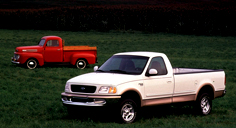The 1948 F-Series pickup was Ford Motor Company’s first all-new vehicle after World War II. Initial buyers were mostly farmers, manufacturers and small businesses, attracted by the promise that the new pickup was "Built Stronger to Last Longer."

In the 60 years since the F-Series was introduced, it has remained a popular vehicle. As of the end of 2007, F-Series was also America's best-selling vehicle—car or truck—for 26 years in a row.
Business and Pleasure
By the 1950s, Americans were buying pickups for recreation, and F-Series began offering more car-like features.
In 1953, F-Series was redesigned for the company's 50th anniversary. The front overhang and wheelbase were restyled for improved weight distribution and reduced turning radius, and the cab was "Driverized," with a curved windshield and new instrument panel. The line's numbering system changed from single digits (F-1) to hundreds (F-100), and the F-2 and F-3 merged into the F-250.
In 1959, F-100 and F-250 became the first Ford trucks to offer a four-wheel-drive option. By the mid-'60s, two of every three commercial customers also were using their trucks for recreation or personal use.
A "New" Take on Trucks
Ford Motor Company unveiled its "New Generation" of light trucks in 1973, adding two inches to the wheelbase. The first SuperCab arrived in 1974, followed by the F-150 one year later.
In 1977, two new, two-barrel, V-8 engines were introduced, a 351- and 400-cubic-inch. The F-100 four-wheel-drive ended production the same year, foreshadowing 1984, when the entire F-100 line was dropped. In 1978, F-Series sales topped 864,000.
Redesign and Innovation
During the 1980s and 1990s, F-Series innovations set the pace for the growing truck market. For 1980, F-Series had a more aerodynamic cab and car-like interior. A fuel-efficient, 3.8-liter V-6 was introduced for the F-100 in 1982. Rear anti-lock brakes became standard in 1987—a first for pickups—and a driver's side air bag became standard in 1994.
A standard, three-door SuperCab—an industry first—was added in 1997 during a complete redesign of the under-8,500-pound Gross Vehicle Weight (GVW) F-Series. The 1997 F-Series was named "North American Truck of the Year" by a panel of journalists and "Truck of the Year" by Motor Trend magazine. In 1999, a standard fourth door was added to SuperCab. In 2001, an F-150 SuperCrew package featured four full-size doors and a full rear seat.
All-New 2004 F-150
The F-150 for 2004 set a new standard for full-size pickups: 46 different cab/chassis/bed configurations plus five distinctive interior designs. Custom interior environments were created for each series. A new 5.4-liter, three-valve Triton V-8 engine offered 15 percent more power, and there was more room for both occupants and cargo. The 2004 F-150 won at least 19 awards and honors; it was named "North American Truck of the Year" by North American automotive journalists and "Truck of the Year" by Motor Trend magazine. It became the first pickup to receive "best pick" in frontal offset crash testing performed by the Insurance Institute for Highway Safety.
In the Green
F-Series recorded double-digit sales increases five months straight, every month after the all-new F-150 went on sale in fall 2003. This streak included an all-time F-Series September sales record. A different sort of green milestone occurred in mid-2004, when production of the F-150 began at the Ford Rouge Center, transformed from an icon of 20th-century manufacturing into a model of 21st-century lean, flexible and sustainable manufacturing.
Today’s F-Series
In 2007, the Ford F-Series was America’s best-selling truck for the year—the 31st year in a row that F-Series held that distinction.

